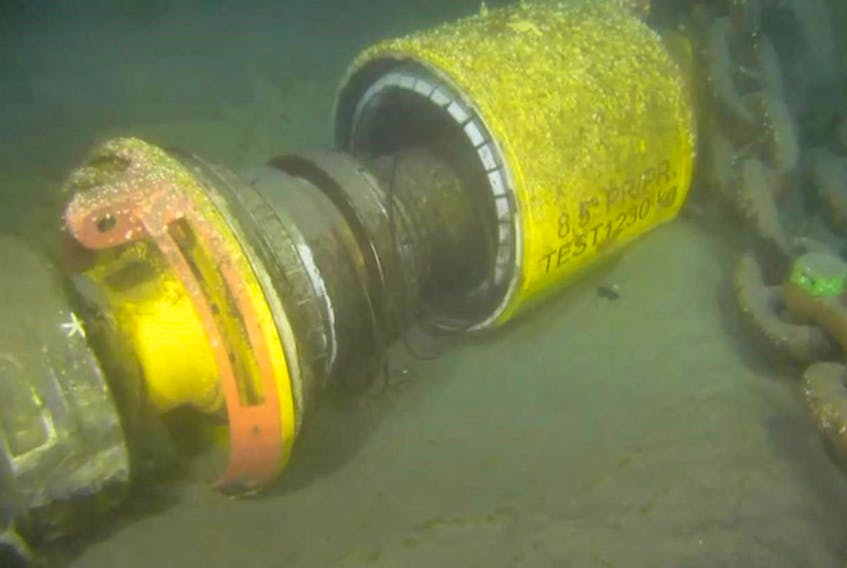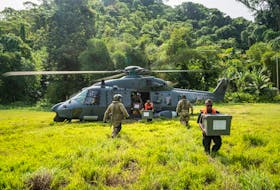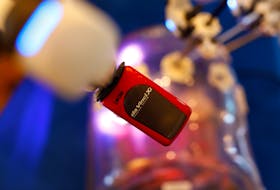Senior management with Husky Energy say they still don’t know exactly what went wrong at the SeaRose vessel to cause the largest oil spill in Newfoundland and Labrador’s history.
At 12:30 p.m. on Friday, Nov. 16, 250,000 litres of fuel leaked from a flowline connector near the White Rose Extension oil well.
The vessel was attempting to restart oil production after an initial shutdown due to a storm – which has been noted as the strongest storm on the planet at the time.
The Husky vessel was the first of the six offshore oil producers to attempt to restart production. In preparation for the restart, warm crude oil was pumped back through the lines as a way to flush out any gases that had gathered since the shutdown. During the flushing of the pipes, oil pressure dropped, and crews realized an oil spill had taken place.
Trevor Pritchard, senior vice-president of Husky Energy Atlantic Region, says at this point, it appears Husky followed the guidelines for a safe startup – yet still the oil rushed into the North Atlantic.
“So far, within the investigations, it’s apparent that we followed our procedures,” said Pritchard.
“The crews are demoralized because we had the spill. No one wants to be recognized with the spill. We learn from this. Is there anything in our management system that would have attracted us to do something differently? We’ll continue to investigate and learn from that.”
Pritchard says the leadership on the vessel examined the conditions of the sea and inspected for any damage the vessel had sustained during the storm. Finding no immediate reason not to begin production, the flushing operation began.
“The leadership team on board, the ones with their feet on the ship, they look at the weather conditions,” he said.
“We do like to start up in daylight, so the time we get to true production was going to be in the afternoon. They would feel like the ship was stable depending on the sea state itself. Given that they felt comfortable on the decreasing conditions and the safety equipment was all in place, then they felt they had the authority and willingness to start production.”
It remains unclear whether the failure of the single component was caused by damage during the storm or whether the piece was destined to fail with or without any other damage.

“We’re not too sure yet, until we get that component up and see what the failure mechanism has been. It can’t have been from overpressure, because the system was operating at such a low pressure compared to design. Why did it fail? We just don’t know yet,” he said.
The component is rated to withstand 31,000 pounds of pressure. The oil used to flush the system was pumped at around 4,000 pounds of pressure.
It’s the second major incident involving the SeaRose vessel in the last year and a half.
In May 2017, an iceberg came within 180 metres of the vessel. Despite coming so close that the crew were told to “brace for impact,” production continued.
Pritchard acknowledged the failure in the iceberg incident and says the company continues to learn, to prevent future incidents.
The Canada-Newfoundland and Labrador Offshore Petroleum Board (CNLOPB) has the authority to order offshore producers to halt all operations. The board didn’t use the authority in advance of the storm, as the producers did so voluntarily.
But the board does not have the authority to tell producers when it’s safe to restart operations – that’s left up to the producers. Pritchard says leaving that to the discretion of producers is the best policy.
“It’s incumbent on us to determine when to start and stop. If the authority was given to the CNLOPB, now it’s their authority to start and stop. They’re not best placed, in my mind, to give those,” said Pritchard.
“Certainly, if they see an extreme event, the stop order is a good tool in their kit.”
Natural Resources Minister Siobhan Coady agrees with Pritchard on that point, but says it’s something the investigation into the spill will have to consider.
“Imagine if an authority said, ‘You have the ability to go forward,’ and then something happened,” she said.
“The operators do have to have some responsibility here. It’s very, very important for safety and environmental protection that they have responsibility. We don’t want to release them from that responsibility.”
— Coady
When it comes to the spill, it doesn’t appear there’s anything to clean up.
Flyovers of the spill area conducted so far have not spotted an oil sheen on the surface. That means the oil is either underwater or has dissipated. While the full scale of the impact on marine life in the area is still under investigation, 14 seabirds have been seen covered in oil. Three of those birds are on their way to St. John’s for treatment.
Models of the ocean currents by Husky show the oil slick should move away from the island portion of the province, farther out into the Atlantic Ocean. That could cause questions of jurisdiction should the oil make it to international waters, but Coady was unsure about exactly what difficulties could turn up if the oil makes it to international jurisdiction.
Up to a dozen different government and private entities are investigating the spill, including the Department of Fisheries and Oceans, the Coast Guard, the CNLOPB, the federal department of environment, as well as the other oil producers in the area, which are keeping an eye out for distressed wildlife.
Of the other operators, only ExonMobil’s Hebron platform has resumed production.
Three lifeboats were damaged during the storm on the Hibernia platform, so the platform will remain out of commission for now, with a reduced staff of 175 people.
The Terra Nova vessel, Husky’s Henry Goodrich and Suncor’s Transocean Barrents all remain out of commission until repairs can be completed for other damage.
Have your say
Want to wade into the debate? Write a letter to the editor and email it to [email protected] Be sure to include a name, address and daytime telephone number where the author can be contacted. Ideally, letters should be no more than 500 words, to a maximum of 700 words.









